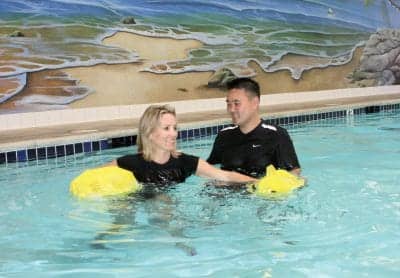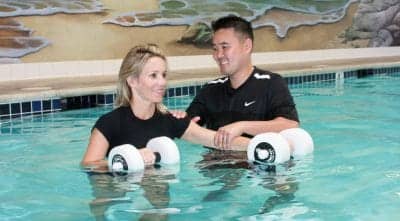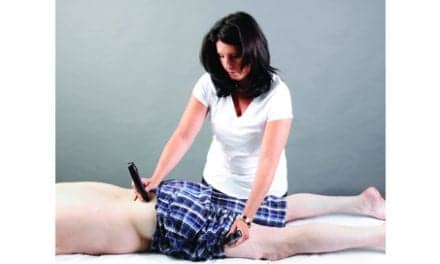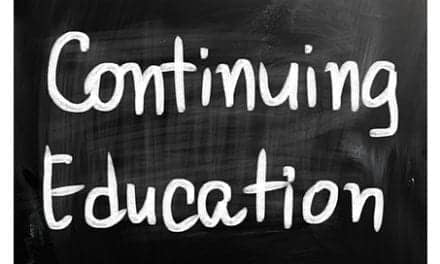
For this accelerated rehabilitation approach to work optimally, the physical therapist must be in the water with the athlete to offer hands-on technique and observe the athlete’s motions while immersed.
Starting in the mid 90s when the “accelerated” protocol for knee rehabilitation became popular, physical therapists who specialize in working with athletes have tried to initiate therapy as soon as could be safely allowed after injury or surgery so that athletes could make the fastest possible return to their sports. During that time, physical therapists learned they could cut weeks or even months off the rehabilitation process by restoring function both proximally and distally to the injured area—offering protection to the injury site while simultaneously reducing pain and edema. In the years that followed, this accelerated approach has reached into all therapy protocols and coincides with techniques used by surgeons who perform “micro” and “minimally invasive” surgery. We have applied this same strategy among our six Athletic Physical Therapy practices, headquartered in Los Angeles, to develop a program that achieves accelerated rehabilitation through aquatic therapy.
Aquatic therapy is often associated with patient populations that are lower functioning and unable to participate in land-based rehabilitation. The gentle and soothing effect of water therapy has been shown to help conditions such as fibromyalgia, rheumatoid arthritis, osteoarthritis, and total knee replacement, underscoring the effectiveness of aquatic therapy among patients affected by these conditions. Aquatic therapy programs used to treat individuals affected by these conditions, however, are often essentially exercise sessions directed to a small group of people, and directed by a person from the deck of the pool. While these types of programs can be effective, it is our experience that aquatic therapy has much more to offer—not only in substance but to a different type of patient population.
Aquatic Therapy Early Intervention (ATEI) is a systematic program offered to the more active athletic population of patients. What makes ATEI effective is its use of the distinct qualities of water to protect healing tissue while simultaneously allowing early motion and neuromuscular integration. It can also be used to initiate mid stages of rehabilitation faster than land-based programs. Aquatic therapy is also an effective way to build strength, demonstrated in studies that reveal aquatic exercise can help increase the vertical jump of volleyball players. The ability to use aquatic therapy early on, however, is the cornerstone of the ATEI program. This benefit is underscored by a study of an athletic population demonstrating that early range of motion exercises in the pool or whirlpool as part of nonoperative treatment improved return to sport and achieved results comparable to surgery or immobilization.
The ATEI program begins earlier than a land-based program, allowing the injured area to receive a lower dose of therapy, which ultimately accelerates the rehabilitation continuum. That means athletes can take off those walking boots, ditch their slings and crutches, and get back to doing what the body likes most—moving.
HANDS ON THE ATHLETE
The ATEI program is a hands-on approach focused on ensuring appropriate restoration of muscle-length relationships, normal osteokinematics, and joint arthrokinematics. For the program to work, the physical therapist must be in the water with the athlete to offer hands-on technique and observe the athlete’s motions while immersed. Early in the recovery process, hands-on techniques for mobilization, proprioceptive cuing for muscle facilitation and inhibition, are vital for the restoration of motion and muscle function. Land-based therapists have utilized these techniques for years, but were at a disadvantage because patients were unable to come into the clinic until tissue and bone structures had healed sufficiently to tolerate the forces of gravity. Physical therapists who use the methods of ATEI are able to take advantage of the properties of water—buoyancy, viscosity, and turbulence—to get their patients into rehab earlier, regaining motion and function without compromising tissue or bone integrity. This ultimately leads to less downtime, improved outcomes, and quicker ability to return to sport.
MECHANISM OF WATER
In order to understand the underlying mechanism of the ATEI program, we should first take a quick look at the mechanism by which water affects the body. There are three properties of water that the physical therapist must understand and, more importantly, control in order to initiate the ATEI program:
Buoyancy: The body part immersed in water experiences an upward force equal to the weight of the water it displaced.
Viscosity: The friction that occurs between molecules of water.
Turbulence: Increasing the speed of exercise and using equipment creates turbulent water flow and thus proportionally increases resistance.
UNIQUE QUALITIES OF WATER
Water affords a different perspective than land therapy in that the resistance or load is not tied to gravity. In water, the direction and velocity of movement, as well as the shape of the body part or equipment moving through the water, are key factors that control the load placed through an injury. Following are definitions of how each applies in the context of ATEI:
Direction: As the body part becomes submersed, the displacement of water increases, creating an upward thrust by the water on the body part. This can be used to increase or decrease resistance on a body part depending on the position of that body part.
Velocity: The faster a body part is moved through water, the greater the viscosity becomes, resulting in additional resistance.
Shape: Objects or body parts that are tapered as they enter or go through the water produce less turbulence and thus experience less resistance.

To initiate the Aquatic Therapy Early Intervention program, the therapist must understand and control the buoyancy, viscosity, and turbulence properties of water.
IMMERSE YOURSELF
Physical therapists are experts in observing and assessing mobility. The ability of therapists who use ATEI to accurately observe, assess, and correct for movement dysfunction is imperative and it must be performed using various immersion techniques. It is not enough to stand above the water level and surmise what is happening below. How accurately can the therapist assess glenohumeral mobility, scapulohumeral rhythm, or lower extremity joint mobility during the gait cycle from above the water? It is impossible to do accurately due to water refraction. In addition, accurate observation and assessment is the key component that leads to appropriate hands-on techniques for restoration of proper function.
At its most basic level, immersion observation can be performed by the physical therapist donning a pair of goggles. More often, however, it is accomplished through the use of a mask and snorkel, allowing the therapist to stay immersed for longer periods of time in order to observe, assess, correct, and reassess. Advances in technology also allow for a third option, which involves using underwater video to help in assessment. This relatively inexpensive technology allows the physical therapist to analyze subtle impairments for early correction before the athlete develops compensatory movement patterns that carry over when they progress to land-based therapy.
CASE STUDY 1: JOHN D.
John D. is a 19-year-old male with a 3-year history of multiple dislocations related to sporting activities that required a surgical procedure called the Bristow-Latarjet. This surgery involves transfer of the coracoid process with its attached muscles to the deficient area over the front of the glenoid. This replaces the missing bone while the transferred muscle acts as an additional muscular strut, preventing further dislocations. Early postoperative therapy must protect the repair of the subscapularis as well as the developing bony union of the coracoid process.
John D. was seen for athletic aquatic therapy early postoperatively utilizing the ATEI program, with a focus on regaining early motion and facilitation of rotator cuff and scapular stabilizers. An additional task of the program was to protect healing bony unions and soft tissues. Initial assessment consisted of immersion observation utilizing mask and snorkel to assess early glenohumeral and scapular mobility. The patient’s upper extremity was immersed 100% to unload tissues, and a buoyancy device was used for passive abduction and flexion in scapular plane. Compensatory movement patterns were noted early with scapular elevation occurring during the first 30 degrees of glenohumeral abduction. Using hands-on techniques and a decreasing amount of buoyancy assistance, proper early scapulohumeral rhythm was attained and noted upon reassessment with immersion observation. Early treatments consisted of gaining motion to 90 degrees in scapular plane with emphasis on ensuring proper scapulohumeral rhythm throughout movements.
John D. was progressed to range of motion in scapular plane beyond 90 degrees of flexion with use of increased upper extremity buoyancy devices and submersion of head with use of mask and snorkel. Immersion observation was continued to ensure proper mechanics with use of hands-on proprioceptive techniques for inhibition or facilitation. The patient also was put in relaxed dependent supine position utilizing flotation devices, and manual therapy techniques were performed for early passive rotation motions within limitations of healing tissues and bony unions. Isometric strengthening was initiated early on using various hand positions (controlling direction and surface area) with forward and backward walking (controlling velocity for load on tissues). In addition, early scapular stabilization was initiated with use of water wheels with adjustments made in surface area and velocity to control load on tissues.
John D. was seen for eight visits utilizing the ATEI program, then progressed to land-based therapy. With hands-on techniques to ensure proper mechanics and consistent immersion observation, he was able to transfer to land-based therapy ahead of those who would have waited for initial land-based treatments only.
CASE STUDY 2: MONICA V.
Monica V. was status post allograph ACLR and was unable to perform land, step-down exercises properly secondary to poor eccentric quadriceps control. This led to excessive knee valgus and hip adduction/internal rotation. She was placed in the ATEI program where she was able to maintain proper rectus knee positioning secondary to the effects of water buoyancy. Direct underwater observation showed she was able to perform other various squat and lunge activities in the pool with superior mechanics compared to land-based exercises because of the absence of excessive quadriceps overload from gravity.
Monica V. was also able to challenge her knee to perform greater ranges of motion in the water because her quadriceps and knee were assisted by the effects of buoyancy. She was able to perform squats to greater degrees of knee flexion angles and was able to maintain good control of her trunk with the help of the water. The pool in which she performed her exercises featured a smooth gradual decline in the pool depth that allowed the therapist to manipulate precisely the amount of body weight necessary to maintain proper neuromuscular control.
Using the unique qualities of water, Monica V. was able to move quickly and smoothly in the water with a controlled amount of force exerted on her knee and surrounding musculature. Hopping double and single leg can be well controlled in an aquatic environment with proper depth adjustments. During the course of aquatic therapy, early aquatic running exercises were also initiated to facilitate a smooth transition to land-based running. Aquatic plyometrics can be a helpful training tool by permitting early sport-specific training. For example, aquatic plyometric exercises have been shown to increase vertical jump in female volleyball players. Also, Monica’s core stabilizers were continually challenged in a pool where the water constantly exerted gentle resistance against her core muscles. Her sport—women’s professional football—will pose a challenge to her body from head to toe, so her core was not to be ignored.
Another compelling reason to introduce aquatic therapy to athletes is for use in pain reduction caused by conventional exercise. Monica V. experienced reduced pain when she exercised in the pool because of the controlled load on her knee while the water maintained a sufficient gravitational force against which she could work. Eccentric exercise can be reduced and greatly controlled in an aquatic environment, which can lead to greater comfort for patients.
There are many ways to assist a patient’s recovery with aquatic exercise, but an underlying factor that needs to be considered is whether their specific sport is based on land or in water. If an athlete’s sport is land-based, they will need to eventually train on land to effectively return to sport.
Stephen Clark, PT, DPT, OCS, MBA, is the president and founder of Athletic PT, a sports and orthopedic private practice with multiple locations in Los Angeles and Ventura counties.
Marc Mirish, PT, DPT, MBA, is the clinical manager at Athletic Physical Therapy, Thousand Oaks, Calif.
Ethan Ezaki, DPT, is the clinical manager at Athletic Physical Therapy, Oxnard, Calif.





